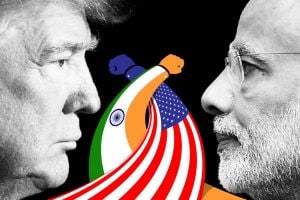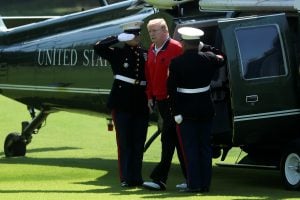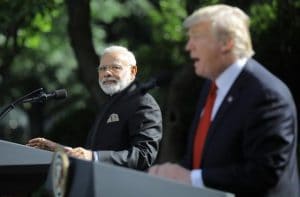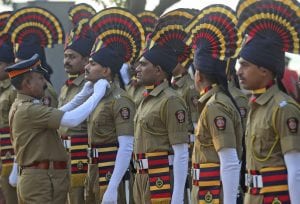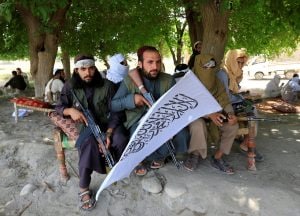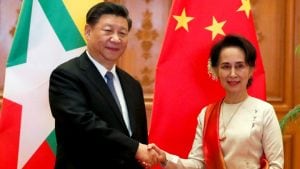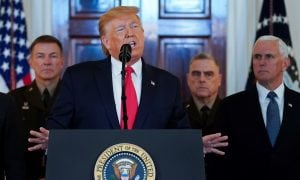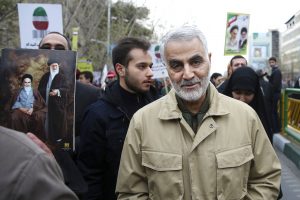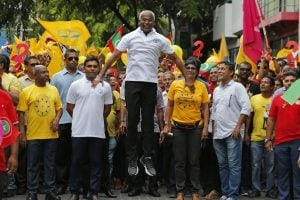Backstage, Trump will be talking Kashmir with Modi—but the path he’s advocating is doomed
Summary
From a distance, it might have been mistaken for an early autumn snowfall: torn leaves of a Quran fluttered all around the famous Rozabal ziarat in Srinagar; the grave of the saint Yuz Asaf, believed by some to in fact be the resting place of Jesus, had been dug up. In the small village of …
From a distance, it might have been mistaken for an early autumn snowfall: torn leaves of a Quran fluttered all around the famous Rozabal ziarat in Srinagar; the grave of the saint Yuz Asaf, believed by some to in fact be the resting place of Jesus, had been dug up. In the small village of Wutligam, a woman charged with promiscuity had been marched to the village square and then shot through the back of the head. In Arigam, jihadists looted the store of Hindu grocery-store owner Raj Nath; in Arizal, they tried to assassinate the pro-India politician Ghulam Qadir.
In August 1965, Hayat Mir—a crack intelligence operative with special forces training— had crossed the Chor Panjal pass with the columns of advancing Pakistan army troops. Then, perched on the mountains near the Baba Reshi shrine, he abandoned his uniform: Mir’s job was to provoke a mass Islamist insurgency against Indian rule.
Two years earlier, sitting in his office in Washington, DC, Central Intelligence Agency officer-turned-diplomat Robert Komer had watched the unravelling of a secret United States effort to mediate on Kashmir—and predicted it would end in just such bloodshed.
“Everybody from (Field-Marshall) Ayub (Khan) down is on a new hate-India jag”, he observed in a terse October 22, 1963 missive to President John F Kennedy’s National Security Advisor, McGeorge Bundy. The Pakistanis, he noted, “appear to be deliberately building up tensions over Kashmir”.
“I cite this not because I lack sympathy for the Paks but because until we do give them a cold shoulder on this sort of business we’ll continue to have all sorts of problems”.
Four weeks later, President Kennedy was assassinated. The prospect of peace in Kashmir was buried with him. Indeed, the failed effort of 1961-1963—into which declassified documents now give historians granular insight—helps understand why the road to peace in Kashmir has so often led, paradoxically, to war.
Later today, when when the folk-dances and hugs celebrating the India-United States relationship are done, Prime Minister Narendra Modi and President Donald Trump will get down to the real business—backstage. There’s little doubt Kashmir is high on President Trump’s mind. Last summer, President Trump outraged India’s foreign policy establishment by asserting Prime Minister Modi had asked him to meditate on the Kashmir conflict—and then brushed off New Delhi’s denial, to repeat his claim.
Early this year, Trump went even further, saying that he and Prime Minister Imran Khan were “working together on some borders, and we’re talking about Kashmir”.
The reasons for Trump’s interest isn’t opaque. Hoping to pull out of the endless war in Afghanistan, President Trump has negotiated a peace deal with the Taliban. There’s even odds, though, that the Taliban might use a drawdown in United States troop levels to overrun major Afghan cities. That would be a disaster for Trump’s re-election prospects—and he needs the Taliban’s patrons, Pakistan’s Inter-Services Intelligence Directorate, to keep them to their word.
Islamabad’s support, however, comes with a price-tag: support on securing concessions in Kashmir.
President Trump also has other reasons to intervene on Kashmir. Like President Kennedy, he sees India as a strategic buffer against China—but the conflict over Kashmir gives Beijing leverage across South Asia. He is also apprehensive, with good reason, about the conflict escalating into a large-scale war, even a nuclear conflagration with catastrophic impacts on the region.
For these very reasons, President Bill Clinton had offered to mediate over Kashmir in 2000, while President Barack Obama had hoped his Afghanistan envoy, Richard Holbrooke, would be able to engage Islamabad and New Delhi on the issue.
New Delhi, in turn, has often sought international help—though it doesn’t like the word meditation. United States mediation helped bring a rapid end to the Kargil war in 1999, and since 26/11, it’s played a key role in tempering Pakistan’s use of jihadists against India. Following the Balakote air-battles, which mercilessly exposed gaps in India’s military preparedness, New Delhi has also lobbied hard for Washington to hold back Pakistan from staging terrorist attacks which could force it to risk another crisis.
This all makes mediation—conducted in secret, so it doesn’t appear to be mediation—seem like an excellent idea to many in Washington, Islamabad, and even New Delhi. Except, it isn’t.
In the autumn of 1961, Komer floated the idea of a grand India-Pakistan bargain that read like a Wagah candle-waver’s dream: a common air-defence system; a customs union; even joint management of agriculture in Punjab. This, he hoped, would allow India and Pakistan to negotiate a new relationship in Kashmir: perhaps New Delhi could be persuaded to give up “a little more wasteland up in Ladakh”, and some minor territorial concessions alone the ceasefire line of 1948; perhaps there could even be “joint tenancy” in the Kashmir valley.
The China-India war of 1962 gave traction to Komer’s proposals: New Delhi now desperately needed United States military aid, and Washington thought it could use the opportunity to push for progress on Kashmir.
Late in 1962, the United Kingdom’s secretary of state for Commonwealth relations, Duncan Sandys, and the United States’ Assistant Secretary of State for Far Eastern Affairs, Averell Harriman, were dispatched to South Asia to determine what military assistance India needed.
Lord Louis Mountbatten travelled with Sandys on this mission, hoping to persuade Nehru to agree to a demilitarised and independent Jammu and Kashmir. India’s cabinet, however, shot down the idea. The diplomats did, however, succeed in pushing Nehru and the Pakistani military dictator General Ayub Khan, who had taken power in 1958, to the negotiating table.
After two rounds of talks, an event took place which, for all practical purposes, destroyed the prospects of an accord. Zulfikar Ali Bhutto, who had taken over as Pakistan’s Foreign Minister, travelled to Beijing in March 1963 and ceded parts of Pakistan-occupied Kashmir to China.
To the President, Komer was blunt. “I wonder if we aren’t doing ourselves a disservice by our continued pressure on Kashmir”, he wrote in a May 14, 1963, note for Kennedy. “There is no denying the great value of a Kashmir settlement to us”, he recorded, “and until recently, I was as much of a hard-liner as anyone on this issue. I would be still if I saw a sporting chance”.
In reality, Komer argued, the prospects of a deal had been “dimmed by Pakistan’s own excessive appetite and misguided tactics, such as trying to use the Chicoms (Chinese communists)”. Talk of Indian concessions on Kashmir, he went on, would engender “a dangerous Pakistan emotional reaction”.
“The longer we nurture Pak illusions”, Komer told Kennedy, “the more a head of steam is built up in Pakistan, and the harder such a reaction will be to head off”.
From the memoirs of Lieutenant-General Gul Hasan Khan, we know just how high that head of steam had built up: hoping to pressurise India into making the concessions President Kennedy sought, it prepared to use force. There was, General Khan wrote, to first being an “intensification of the firecracker type of activity that was already current”, a reference to terrorism. Then, the Pakistan Army was to train guerrillas like Hayat Mir, who would be tasked with “arming the locals and helping them rise against the Indian Army of occupation”.
Then, on August 29, 1965, Pakistan’s army chief, General Mohammad Musa received secret orders to initiate full-scale war: “a general rule”, the orders read, “Hindu morale would not stand for more than a couple of hard blows delivered at the right place and the right time”.
New Delhi’s own position in Kashmir hardened in the build-up to the war, with Prime Minister Nehru moving to tie the territory closer into the Indian union. In 1963, with the political patriarch, Sheikh Muhammad Abdullah in jail on charges of seeking independence, Nehru’s hand-picked regional strongman, Ghulam Muhammad Bakshi, ceased to call himself Kashmir’s wazir-i-azam, or prime minister and picked the standard title of chief minister instead. The arrangement would be formalised by the legislature in 1965.
In late 1964, an order issued by the President of India allowed the central government to take charge of Jammu and Kashmir’s administration in the event of the collapse of the constitutional machinery. Prior to this order, the imposition of emergency powers required the concurrence of the state legislature. A wide variety of central legislation was made applicable to Kashmir; high officials and candidates contesting elections now had to vow to “uphold the sovereignty and territorial integrity of India”.
Then, in January 1965, the Indian National Congress amended its party constitution and enabled the setting up of a state unit in Jammu and Kashmir which in turn simply subsumed the National Conference, then led by chief minister GM Sadiq.
For both Islamabad and New Delhi, there are important lessons in those events. Pakistan’s efforts to seize Kashmir failed spectacularly: far from rising in support of jihad, the villagers of Wutligam and Arizal were repelled by jihadists like Hayat Mir and betrayed them to police. New Delhi’s integrationist efforts, in turn, failed: incarcerating Sheikh Abdullah in jail, and the National Conference-Congress merger, left the state without legitimate political opposition, strengthening the Islamist tendencies that would explode in the 1980s.
There’s an even more important lesson for the United States. Kennedy’s peace efforts, no matter how well-intentioned, had led both India and Pakistan to sharpen their swords, not beat them into ploughshares. Either hoping to secure concessions or to avoid having to make them, both nations hardened the status-quo—a process that led on, inexorably, to war.
Late on the afternoon of November 17, 1965, Hayat Mir walked into the lunch-room at Srinagar’s Ahdoos Hotel, to discuss plans to take forward the jihad in Kashmir after Pakistan’s military defeat. Plain-clothes police personnel were waiting. “This is the first time in my life I have failed,” police files record him as saying.
Everybody failed: Washington, Islamabad, and New Delhi alike. Leaders who don’t read history are condemned to repeat its errors. The path President Trump is now embarked on with Prime Minister Khan leads to the same destination so many other leaders found themselves at: a grim, blood-soaked place called an impasse.

Elon Musk forms several ‘X Holdings’ companies to fund potential Twitter buyout
3 Mins Read
Thursday’s filing dispelled some doubts, though Musk still has work to do. He and his advisers will spend the coming days vetting potential investors for the equity portion of his offer, according to people familiar with the matter


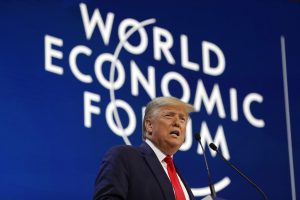






 Listen to the Article
Listen to the Article  Daily Newsletter
Daily Newsletter





